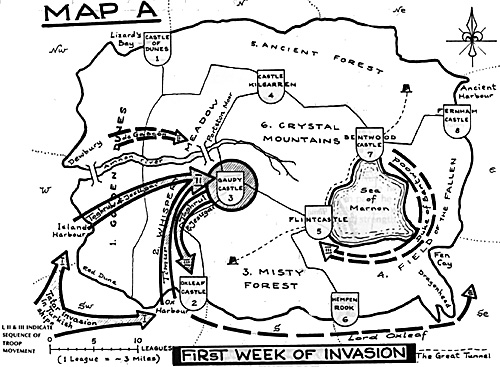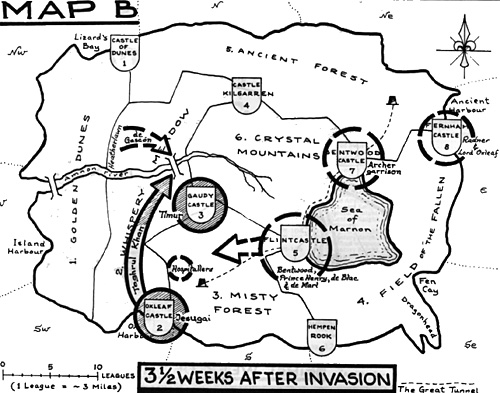The First Invasion
Unlikely as it seemed, ships were sighted off the West coast by one of Lord Oxleaf's patrols in Red Dune in the early morning light, just three days after the Amnon Waterday celebration in 1231. The vessels were clearly of Turkish design, and no one doubted the Tatars could easily "persuade" the Turks to permit their use in an invasion attempt.
Lord Oxleaf's fears were confirmed. His small castle garrison of 120 (each figure = 20 troops) appeared doomed from the start. A messenger was on the way to Flintcastle and Bentwood, with hopes Island Harbour, and not Ox Harbor, was the invasion site giving Oxleaf an extra 2 days to build up what defense he could. But by next morning, ships were seen approaching both harbors. Oxleaf prepared to hold his castle long enough for a relief force to reach him from Bentwood.
Montreil de Gascon was at Dewbury when his party saw Turkish ships entering Island Harbor. A large Tatar force, displaying the Khan's standard, disembarked and proceeded Westward along the River Amnon the following day. De Gascon followed on the opposite side of the river mobilizing troops as he went. A smaller invading force marched North from Ox Harbour evidently intending to join Toghrul Khan's advance and spared Lord Oxleaf-at least for the time being.
Across terrain ideally suited to their 100% cavalry force, the Tatars moved over 10 leagues per day. Within 4 days of the landings and with amazing speed, the invaders penetrated well inland, surrounding the undefended Gaudy Castle with the combined army of Timur, Jesugai and the Khan and took it without a siege. De Gascon, now encamped at Portston Moor, was unable to do anything to prevent it.
 Slow Mobilization
Slow Mobilization
Marnon mobilization was slow and centered around Flintcastle and Bentwood. It was 2 weeks later, before Sir George Radner, in Fernham Castle, got the word. Toghrul Khan wasted no time and leaving Timur with his nomad archers to garrison Gaudy Castle and Kushala's tribal troops to guard the bridge at Portston Moor, doubled back (with J esugai) to march against Oxleaf. Lord Oxleaf knew there was no hope of saving his region now. He seized the Turkish ship in his harbor and embarked with his garrison eastward, along the coast, losing his castle to the Tatars nearly 1000 strong.
The next day, in a drizzling rain, Kushala's 100 spear cavalry were surprised by de Gascon's 300 crossbowmen, who crossed the bridge under their own bolt barrage, driving the surviving Tatar troops into Gaudy Castle. This first short battle demonstrated, without a doubt, how effective crossbow infantry can be when properly led and given an element of surprise! They suffered no losses and Portston Bridge was secure against any Tatar force that could be gathered at Gaudy.
Two weeks after the landings, the Castle of Dunes mobilized, but could only muster feudal militia archers of questionable ability, although in no immediate danger and de Gascon now guarding the river.
The Duke of Bentwood Stirs
The Duke of Bentwood built up a substantial army during those two weeks and leaving his archers in garrison, began his move to Flintcastle with the rest of his forces, just 16 days after the start of invasion. It turned out to be an ardous march, around the Sea of Marnon, taking 5 days to reach deBlac's castle. This was necessary in order to avoid taking heavy cavalry (majority of Bentwood's troops) over the mountains, as The Great Tunnel could only accomodate infantry and Crystal Mountains were nearly impassable for horses.
On reaching Flintcastle, the Duke was met by Falcon de Blac in company with Sir John deMarl and Sir Henry, Prince of Dunes; both of whom had returned to Marnon just the week before. This was cause for celebration ! Fl intcastle took on a festive air wh i le the troops rested and the nobility feasted. Montreil de Gascon never forgave himself for missing any such bash, let alone one attended by the Duke himself. He was said to have been furious, on hearing of it later, to the point of inviting his Tatar enemies to a wild and sumptous orgy he hosted in respite.
All this did not go unobserved by Jesugai's scouts in the Misty Forest, who also discovered a Hospitaller unit of pikemen, 250 strong, at Marls Gate. Meanwhile, taking advantage of terrain ideally suited to his light and medium cavalry, Toghrul Khan departed Oxleaf Castle proceeding northward across the meadowlands and Amnon River to one of the northern castles, with obvious intentions.
An additional 120 secular knights joined deGascon at Heatherlawn, intent on delaying the Tatar advance at Portston Bridge. Sir Henry, the Prince of Dunes, was to lead his medium foot (spears) through the tunnel to join the Hospitallers at Marls Gate and await Bentwood's army there, putting them all within reach of both occupied castle. Perhaps the Dune family vow to secrecy prevailed for, instead, Henry decided to stay and garrison Flintcastle while deBlac was on the move with the main advance; once the feasting was over, that is . . . A buildup at Marls Gate posed a major threat to Tatar gains and had Toghrul Khan anticipated it, he would probably have stayed in Oxleaf.
The Return of Oxleaf
The Lord Oxleaf had been at sea for a week before reaching Fernham to join Sir George Radner there. Fernham, along with the entire Northeastern part of Marnon, was in complete ignorance of the invasion and Radner must have been rather shaken by the terrible news Oxleaf brought, surely amplified by the Lord's belief that deMarl and Sir Henry were still abroad. Even though between them, Sir George and Oxleaf had a substantial force of veteran troops, they stayed isolated for the next 3 weeks or more, without even a scouting party outside the castle walls.
 In nearly a month's time Marnon was mobilized at last, and began to concentrate forces in 3 widely spaced, but distinctive areas of the country. In the East was Fernham Castle with a strong veteran garrison of heavy infantry. In the South was Bentwood, deMarl and deBlac with 80 Men-at Arms and the elite military orders of the Temple and the Teutonic Knights; all heavy cavalry with the finest equipment and arms available; joined by veteran Hospitaller pikemen. In
the Northwest was Montreil de Gascon with his crossbowmen and 120 knights; an all elite force; ready to support the garrison at the Castle of Dunes.
In nearly a month's time Marnon was mobilized at last, and began to concentrate forces in 3 widely spaced, but distinctive areas of the country. In the East was Fernham Castle with a strong veteran garrison of heavy infantry. In the South was Bentwood, deMarl and deBlac with 80 Men-at Arms and the elite military orders of the Temple and the Teutonic Knights; all heavy cavalry with the finest equipment and arms available; joined by veteran Hospitaller pikemen. In
the Northwest was Montreil de Gascon with his crossbowmen and 120 knights; an all elite force; ready to support the garrison at the Castle of Dunes.
Garrisons in the other 2 castles consisted of the feudal archers left in Bentwood Castle and Prince Henry's regulars at Flintcastle
Most of the invaders' strength lay with Toghrul Khan, now approaching Portston Moor: over 300 medium horse archers and about half as many light spear cavalry led by a tribal chieftain-an all elite force. Gaudy Castle was still in Timur's hands with his 300 elite light archers and Kushala's 80 light spear regulars who survived de Gascon's attack at the bridge. Jesugai's 300 regular light archers were holding Oxleaf Castle.
Marnon continued...
Back to Table of Contents -- Courier Vol. IV No. 2
Back to Courier List of Issues
Back to Master Magazine List
© Copyright 1982 by The Courier Publishing Company.
This article appears in MagWeb (Magazine Web) on the Internet World Wide Web.
Other military history articles and gaming articles are available at http://www.magweb.com